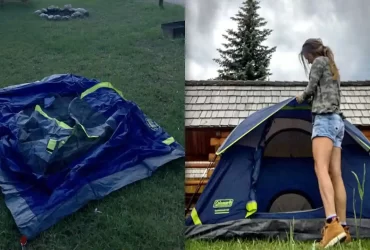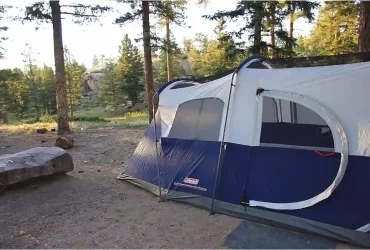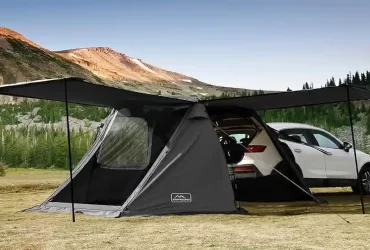One of the most enjoyable trips you can take is hiking in the mountains or camping out in the backcountry. But having camped countless nights, we also know the feeling of lying in your tent and being frozen to death. In order to make sure you stay warm when camping and if you’re in a tent, we’ve listed our top tips below.
This article contains plenty of simple camping hacks to stay warm on colder nights, and we have found that they have been extremely helpful in keeping warm in a tent. In this article, we’ll show you how to keep warm in a tent by making your own hot water bottles and choosing the right gear.
This list is comprised of all the tips we’ve learned from camping in the seasons of the year and some suggestions from other outdoorsy friends. Our camping experiences have greatly improved as a result of all these advice and tips on how to stay warm in a tent, which greatly enhances the fun of camping.
How To Stay Warm In Your Tent While Camping
The following tips are aimed at backpackers and wild campers who must travel light.
Invest in a good sleeping bag

Keeping warm is best with insulation. Heat sources external to the body temporarily relieve the cold. Cold weather camping can cause body heat loss to the ground. This is why your sleep system matters!
The right sleeping bag is important. In the market for new sleeping bags, I agonized over temperature ratings and material (down vs synthetic). After much research, I chose the Big Agnes Sidewinder SL 20 Sleeping Bag. I carry it year-round when camping and backpacking with a temperature rating of 20°F.
Material (down vs synthetic)
It depends on the situation whether down or synthetic fill is more beneficial. Down insulation is warmer and more durable than synthetic insulation (if cared for properly). Water does not affect down’s performance.
Cold, dry camping requires a down sleeping bag. Camping in wet conditions means you’ll need synthetic because it dries faster and is more insulating. Unless you can find a down or synthetic sleeping bag that suits you, you might consider a down/synthetic blend.
You may also like this:
Temperature rating
A sleeping bag’s temperature rating is more complicated than its label number. You should also remember that temperatures are estimates. If the temperature is 20 degrees, then the bag isn’t comfortable.
Men’s bags and women’s bags have different rating systems, so that’s weird. Men’s bags get a lower limit rating (the temperature at which a warm sleeper might be comfortable), while women’s get a comfort rating. The 20-degree bag for a woman is likely to be warmer than that for a man.
However, it can help you find the right bag even if it is confusing. A sleeping bag liner can add up to 25°F of warmth to an already existing sleeping bag if you don’t want to buy a new sleeping bag (because expensive!).
Keep layers on even when it’s warm
Layer up once the temperatures start to drop in the evening – don’t wait until you’re already cold to layer up, it’ll take longer and you won’t get warm.
Big and clever thermals
Thermostats might conjure up images of your granny, but an absolute must if you are camping in the spring, autumn or winter is a decent set of merino wool long-johns or leggings.
Pack hot water bottles

It doesn’t matter if you don’t usually use one at home, or even if you don’t think April will be warm enough to use one, take a hot water bottle anyway.
Alternatively, try the Vango Radiate sleeping bag which works with any USB power pack – part sleeping bag, part electric blanket – and promises warmth at any time!
Be warm before bed

Despite additional bedding, you may remain cold if you get into your sleeping bag cold. Do some star jumps or have a warm drink before going to sleep to bring your core temperature up before snuggling down.
Bag liners can help

Buy a silk sleeping bag liner, they’re supposed to add an extra ‘season’ of warmth, but mine ripped almost instantly. Fleece alternatives help to trap heat and aren’t quite as fragile as silk liners.
Buy down insulation
If you plan to camp in cold weather, down insulation will keep you super warm. There are also lots of innovative synthetic sleeping bags which trap heat very effectively, so do your research.
Footprints or tent rugs

Tent rugs and footprints will not keep you warm (your clothes and sleep system are more important), but they can provide additional protection from the elements.
Tarps or footprints protect the tent’s bottom and prolong its life. In addition, it can help offset the cold from the ground by creating an extra layer between you and it. The use of a rug can also help reduce cold air coming through the tent bottom.
Heat packs are worth it

If you camp, make sure to have disposable heat packs handy. Putting a couple in your sleeping bag or hoody pocket can make a huge difference if you’re cold.
Choose a USB rechargeable hand warmer like the Zippo Hand Warmer or any other reusable option.
Don’t use a massive tent
Unlike a smaller tent, a large tent will remain cooler even when only a few people are inside. The sleeping compartments in larger tents are usually easier to heat up than the living spaces, so if you’re only camping for a short time, downsize your tent, or switch to canvas or polycotton tents that keep heat out better.
Be careful with portable heaters!

When camping with an EHU, it makes sense to take a portable electric heater. Although portable gas heaters need extra care and safety advice, you will still need to follow them. When sleeping or for long periods of time, don’t leave a heater on.
It may be tempting to use an electric heater while camping, but it should be used carefully. Tent bedrooms should not use gas heaters, as they need plenty of ventilation.
Do not leave a gas heater unattended, never use it inside a tent without a vent, and use a carbon monoxide alarm. Follow the manufacturer’s safety precautions.
The Kampa Cuboid and Kampa Diddy are plug-in electric fan heaters designed specifically for camping. This is a safe option, but only suitable for those camping with EHUs.
Sleep with the right bag
Avoid sleeping in cheap sleeping bags or bags that are only meant for summer use (look for a bag with a three-season rating). Keeping warm is easiest with a close fitting mummy bag.
While it might be tempting to take a duvet and throw it over a cheaper, less restrictive sleeping bag, it will not keep you as warm as a technical sleeping bag.
Air beds double in height

The ease of getting on and off a double-height air bed makes it a great choice for those with mobility issues, but they can be very cold. Even with sheepskin rugs on top, I was always cold with one for over a year.
Changing your SIM will drastically improve your nighttime warmth. Alternatively, SIMs can be placed on top of a folding camp bed for greater mobility. Keeping warm with a good SIM is easy thanks to padding and insulation.
Blankets

Make sure you bring plenty of bedding if you are car camping! Firstly, cover the tent’s bottom with a wool blanket (or foam floor cushions). Then cover with sleep pads. After that, you can throw on a huge duvet and stay warm and toasty camping in a tent.
Camping in cool weather is certainly possible. For adventurers, I highly recommend making the most of your gear. Camping gear is useful all year round, so if you enjoy camping, getting more gear is not a bad idea. Stay warm when camping in a tent with these tips.
You may also like this:
FAQs: How to stay warm camping in a tent?
How to Stay Warm in a Tent Without Electricity?
Despite the fact that tents have heaters, you can stay warm without electricity or gas. Tent-friendly heaters aren’t always necessary, but the warmth you gain from your sleeping bag, sleeping pad, and clothing will last much longer.
The weight, safety concerns, and lack of insulation (most tents aren’t well insulated) make tent heaters unattractive. Convenience is my priority when camping, so I avoid taking extra equipment when possible. Make your camping more comfortable with these cold-weather hacks!
Can I camp in cold weather?
Answers to this question are hard to come by! Generally, I judge this from if it is too cold to sleep outside with a regular blanket at night, then I will need warmer clothing.
Inexperienced campers with regular, box-store gear should consider their heat options when the nighttime temperature is below 72 degrees Fahrenheit (21 degrees Celsius).
With the right gear and experience, you can sleep almost anywhere. But if it gets below 20 degrees (-6 degrees Celsius), you might want to prepare for winter camping.
Can a tent really keep you warmer?
Even though it seems crazy, tents can keep you 5-10 degrees warmer at night (depending on quality and size). Adding a degree may not seem like much, but when it’s cold outside, it helps!
How can i safely heat my tent?
Electric heaters, propane heaters, and candle heaters are available today, but they each come with precautions, and making sure that you can use them safely can cost a lot of money. These safer and simpler options might suffice to provide the warmth you need.
We have seriously considered taking my little camper’s electric space heater along when we go car camping (at a place with electricity) with our giant family tent. Whenever we are camping in our family car, our tent is huge. I have often thought that I would like to be able to turn on our space heater when we get into the tent and get ready for bed and when we wake up in the morning and dress in our clothes in order to keep warm. In order to keep myself safe, I have no idea if I would go to sleep with it running at night.
In addition to emergency candles, I have also used them as a way to provide a bit of warmth when we have found ourselves unexpectedly cold while camping in the back of our car. However, we do not sleep with these on when we are awake.
What is the warmest tent that you can buy?
It is a hard question to answer, so I’ll try to make it as short as possible. The answer to this question really depends on so many different factors, including the location of the camp, the weather, the finances, the level of comfort, etc.
There are some who recommend buying an outfitter tent with a wood stove. Some will suggest an insulated ice fishing hut, others will suggest a backpacking tent that can stand three or four seasons, and some will tell you to not worry about it too much.
It is possible to find the right hot tent for you, all you need to do is consider your options a bit and do some research before making your decision.
You may also like this:
Final Thoughts
Camping properly made us spend so many nights lying awake, shivering in the cold and waking up at dawn all for no reason. It was a very unpleasant experience. In addition to our own experience, we’ve learned from other campers we have met along the way tips and tricks we’ve learned over the years.
Due to all of this, we rarely have to deal with being cold inside our tent overnight, allowing us to get out and camp more frequently as well as at all times throughout the year. It is the perfect way to take advantage of the great outdoors. This is why we wanted to make this guide about how to stay warm in a tent, as we know firsthand how miserable a cold tent can be on your trip.
There is really nothing worse than waking up in the middle of the night to find you’ve been unable to sleep. With these steps above, you can avoid these difficulties in the future and enjoy a peaceful and comfortable sleep!
Video: How to Stay Warm and Safe While Camping in the Cold – Cold Weather Camping Tips




Leave a Reply
View Comments